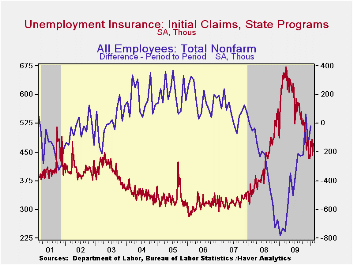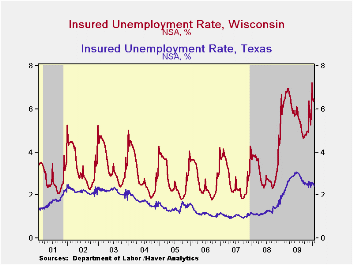 Global| Feb 18 2010
Global| Feb 18 2010U.S. Initial Jobless Insurance Claims Move Back Up
by:Tom Moeller
|in:Economy in Brief
Summary
Today's Labor Department report that initial claims for jobless insurance moved higher last week after falling during the prior period underscores a sideways pattern in place since December. Jobless insurance rose 31,000 to 473,000 [...]
 Today's
Labor Department report that initial claims for jobless insurance moved
higher last week after falling during the prior period underscores a
sideways pattern in place since December. Jobless insurance rose 31,000
to 473,000 following a 41,000 decline that was less than reported
initially for the prior week. Down from the recession peak of 674,000
hit last March, claims remained near the lowest level since September
2008. The weekly rise in claims contrasted with Consensus expectations
for a decline to 430,000. The four-week moving average of initial
claims fell slightly to 467,500 and remained just above the cycle low.
Today's
Labor Department report that initial claims for jobless insurance moved
higher last week after falling during the prior period underscores a
sideways pattern in place since December. Jobless insurance rose 31,000
to 473,000 following a 41,000 decline that was less than reported
initially for the prior week. Down from the recession peak of 674,000
hit last March, claims remained near the lowest level since September
2008. The weekly rise in claims contrasted with Consensus expectations
for a decline to 430,000. The four-week moving average of initial
claims fell slightly to 467,500 and remained just above the cycle low.
The latest initial claims figure covers the survey week for February nonfarm payrolls. There were 3,000 (1.3%) fewer claims in February than during the January period. During the last ten years there has been an inverse 84% correlation between the change in payrolls and the level of initial claims.
Continuing claims for unemployment insurance during the latest week were stable at the cycle low which left them down by one-third since late-June. Continuing claims are at the lowest level since early-January of last year. The overall decline is a function of the improved job market but also reflects the exhaustion of 26 weeks of unemployment benefits. Continuing claims provide an indication of workers' ability to find employment. The four-week average of continuing claims fell to a cycle low of 4,585,750. This series dates back to 1966.
Extended benefits for unemployment insurance fell to a new cycle low of 205,744. They were down by two-thirds from a peak of 597,688 reached in November.
The insured rate of unemployment remained stable for the fourth week at a low of 3.5%. The rate reached a high of 5.2% during late-June. During the last ten years, there has been a 93% correlation between the level of the insured unemployment rate and the overall rate of unemployment published by the Bureau of Labor Statistics.
The highest insured unemployment rates in the week ending January 30 were in Alaska (7.3%), Wisconsin (6.4), Pennsylvania (6.4), Montana (6.3), Michigan (5.7), Washington (5.5), North Carolina (5.3) and Connecticut (5.2). The lowest insured unemployment rates were in Virginia (2.3), Texas (2.4), Florida (3.4), Maryland (3.7), Wyoming (3.7), Mississippi (3.7), Ohio (3.9), Indiana (4.0), New York (4.1) and Maine (4.5)
These data are not seasonally adjusted but the overall insured unemployment rate is.
The unemployment insurance claims data is available in Haver's WEEKLY database and the state data is in the REGIONW database.
The Economy and Why the Federal Reserve Needs to Supervise Banks from the Federal Reserve Bank of Minneapolis is available here.


| Unemployment Insurance (000s) | 2/13/10 | 2/6/10 | 1/30/10 | Y/Y | 2009 | 2008 | 2007 |
|---|---|---|---|---|---|---|---|
| Initial Claims | 473 | 442 | 483 | -25.0% | 573 | 419 | 321 |
| Continuing Claims | -- | 4,563 | 4,563 | -7.8% | 5,835 | 3,345 | 2,552 |
| Insured Unemployment Rate (%) | -- | 3.5 | 3.5 | 3.8 (2/2009) | 4.4 | 2.5 | 1.9 |
Tom Moeller
AuthorMore in Author Profile »Prior to joining Haver Analytics in 2000, Mr. Moeller worked as the Economist at Chancellor Capital Management from 1985 to 1999. There, he developed comprehensive economic forecasts and interpreted economic data for equity and fixed income portfolio managers. Also at Chancellor, Mr. Moeller worked as an equity analyst and was responsible for researching and rating companies in the economically sensitive automobile and housing industries for investment in Chancellor’s equity portfolio. Prior to joining Chancellor, Mr. Moeller was an Economist at Citibank from 1979 to 1984. He also analyzed pricing behavior in the metals industry for the Council on Wage and Price Stability in Washington, D.C. In 1999, Mr. Moeller received the award for most accurate forecast from the Forecasters' Club of New York. From 1990 to 1992 he was President of the New York Association for Business Economists. Mr. Moeller earned an M.B.A. in Finance from Fordham University, where he graduated in 1987. He holds a Bachelor of Arts in Economics from George Washington University.






